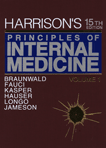 Harrison's Principles of Internal Medicine, 15th edition
Harrison's Principles of Internal Medicine, 15th edition
Editors - Eugene Braunwald, Anthony S. Fauci, Dennis L. Kasper, Stephen L. Hauser, Dan L.Longo, J. Larry Jameson
Reviewed by: Shabbir M.H. Alibhai, MD, MSc, FRCPC, Senior Editor, Geriatrics & Aging.
How does an internist go about reviewing a textbook such as Harrison's? A copy of Harrison's has been with me since I began medical school, which already says something, although I'm not sure exactly what. Certainly when one thinks about a short list of great Internal Medicine texts, this book comes to mind. I suspect that almost every reader has encountered Harrison's in one way or another during training or practice. Thus, I approached this review slightly differently. I examined my clinical Internal Medicine practice in the last month to select the last six questions where I required additional information and thought it fair to consult a textbook rather than a specific study. I then evaluated the 15th edition of Harrison's with respect to its ability to answer these questions. The questions were as follows:
- In a patient with an elevated growth hormone level, how does one go about making the diagnosis of acromegaly?
- What is the best non-invasive test for an older patient with clinically suspected renal artery stenosis?
- Which physical exam maneuvres are useful in diagnosing aortic stenosis?
- Which groups of patients benefit from perioperative beta-blockers?
- How does one treat a patient with relapsed polymyalgia rheumatica (PMR)?
- What is the role of testosterone in the treatment of male osteoporosis?
In general, the text is well laid out, and the index is detailed and reasonable to navigate through. The 15th edition maintains the traditional layout of chapters, although in comparison to an earlier edition, there is a larger chapter on genetics and the somewhat sparse chapter on psychiatry has been subsumed in the chapter on neurology. As usual, I was dismayed to find no chapter or even section devoted to geriatrics and related issues (such as the biology of aging organ systems). The text is clear. Tables, charts, figures and flowsheets abound (even more than in previous editions), and there are new symbols to highlight specific headings such as genetic considerations and treatment (although there is no symbol for diagnosis, which is a pity).
So how did it do in terms of my queries? With respect to the question of acromegaly, Harrison's had nice sections on etiology, presentation and diagnosis. It discussed the role of both growth hormone and IGF-1 in screening and the utility of the glucose tolerance test to help rule in or rule out the diagnosis. Unfortunately, there was no mention of the test characteristics (i.e., sensitivity, specificity) but there was a good reference in the bibliography. With respect to the diagnosis of renal artery stenosis, the material provides a useful algorithm (although only in text form) to make the diagnosis, and actually includes some information on the sensitivity and specificity of magnetic resonance angiography as the best non-invasive test (although it does not provide comparative information for other non-invasive tests). When it comes to physical examination of aortic stenosis, classic findings are described, although the emphasis on detailed physical exam is less in this edition, perhaps reflecting the general decline in popularity of physical examination in modern medicine. What is lacking is information about the utility of any specific physical exam maneuvres in ruling in or ruling out aortic stenosis, which would have been more valuable to me than simply listing some common findings in the JVP, the pulse or the apical impulse.
On to therapeutics. After a frustrating time searching for a discussion of perioperative beta-blockade, I found nothing mentioned about this topic. Perhaps I missed it, but it was neither in the index, the table of contents nor selected portions of the text I examined. Moreover, I noted an absence of any section dedicated to preoperative assessment of patients, which was a clear deficiency. With respect to relapsed PMR, I was surprised to find no separate section for PMR. There was little mention of PMR under temporal arteritis either. There was no information on how to treat relapsed temporal arteritis. Finally, with respect to the use of testosterone in male osteoporosis, there was no mention of testosterone as either a standard or an experimental agent to treat osteoporosis, despite considerable recent interest and a small but accumulating body of evidence. For that matter, the discussion on male osteoporosis was virtually non-existent.
At the end of the day, my assessment of the current edition of Harrison's was less than flattering. Perhaps my questions were esoteric or my standards were too high; I will leave that up to the reader to judge. For myself, I would still keep a copy of Harrison's on my shelf, but I am not sure when I would update my older edition and how often I will use this edition. The information in Harrison's is great for summarizing rare diseases and discussing well known aspects of common diseases. But practical information with respect to diagnosis and management was less than I was looking for, despite over 2600 pages of information. And, the lack of emphasis on quality and quantity of evidence was rather disheartening. Maybe it's time to look at online versions of classic texts.

 Harrison's Principles of Internal Medicine, 15th edition
Harrison's Principles of Internal Medicine, 15th edition